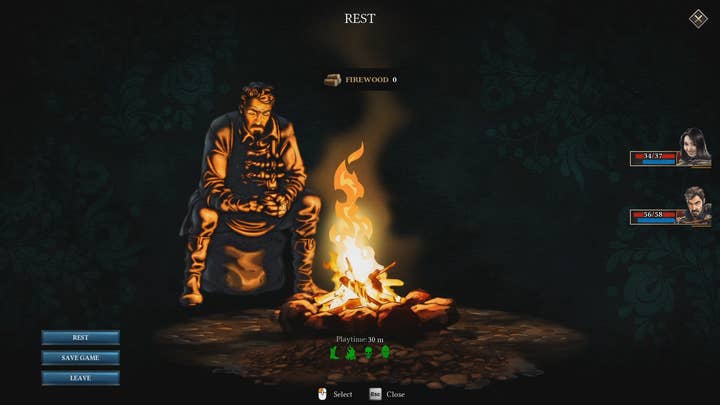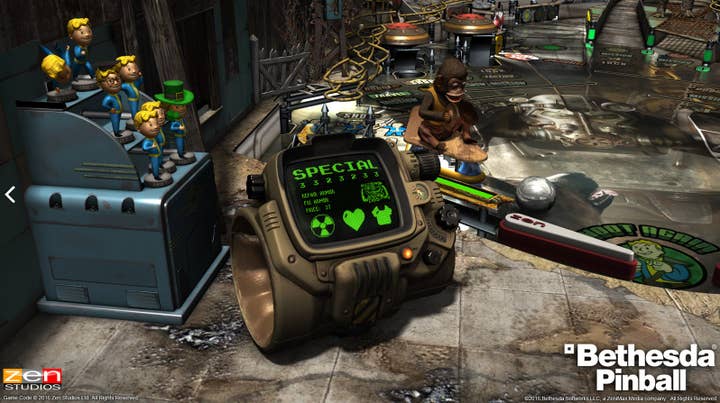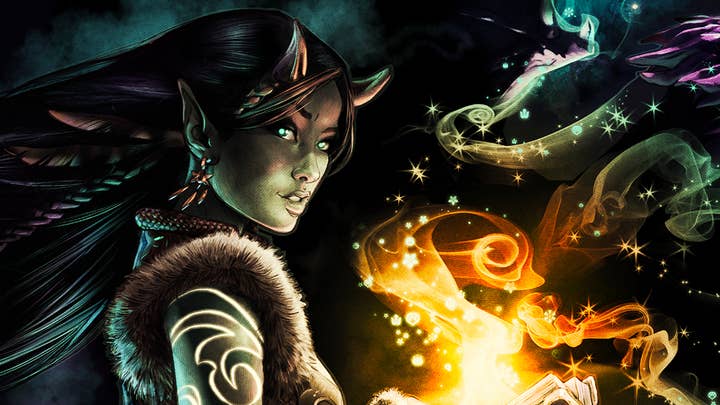How pinball made us better RPG developers -- and vice versa
Zen Studios COO Mel Kirk on what the pinball specialist learned by leaving its comfort zone with two RPG titles
Pinball will always be our first love. We were pinball players at heart long before we released Pinball FX for the Xbox 360, and more than a decade of working on pinball tables -- from Guardians of the Galaxy to Portal -- has permanently woven pinball into our DNA. We've grown a lot since our early years as a company, but we're still a tight-knit team with no shortage of raw passion for our work.
Sometimes that passion means a little too much time at our office pinball table collection -- but that's technically research, right?
At any rate, even our most loyal fans who followed our work from the beginning raised their eyebrows when we committed to producing RPGs alongside our pinball content. Not only did this feel like a departure from our core strengths -- from a fan perspective -- it also felt like a threat to our production of new pinball content. If we were working on RPGs, we might have less time for pinball, and we might phase out pinball development altogether -- or so some very worried players thought.
We understand where these fears come from, and we've seen the companies we love pivot away from making the kind of games we love to play. That's not what Zen is doing. In fact, our expansion into releasing RPGs has dual rewards:
The lessons we've learned could have big implications for other studios debating a similar multi-genre path
- We get to weave pinball sensibilities into an entirely new genre
- Our RPG work opens the door to new kinds of pinball experiences
This is not an intuitive idea at first -- and that's part of the reason why we took this strange path -- but it's compelling when you take it apart. The lessons we've learned could have big implications for other studios debating a similar multi-genre path.
What pinball taught us about RPG design
We could wax philosophically about pinball design for pages and pages, but one of the great beauties of pinball is how much diversity and innovation spills out of an incredibly simple core gameplay mechanic: hit a ball with one of two (or more) flippers to keep it from falling off the table. Out of that idea comes a near unending variety of table components, table effects, tests of timing and skill, and even stories told through the medium of pinball.
Pinball design forces you to be creative within an incredibly narrow scope, and it forces you to put player experience above all else. Pinball is not just about how it looks; it's about how it feels. That amorphous idea of feel comes out in the responsiveness of the flippers, the weight of the ball as it moves and interacts with the rest of the table, and how the environment of the table comes to life as you play.

Constraints breed innovation, and pinball is one of the ultimate expressions of this classic game design concept.
So when we started to step into the world of RPG design with CastleStorm and Operencia, we entered it with a pinball mindset. We narrowed our core mechanics and intentionally implemented constraints on our design team, which can be difficult to stick to in an industry where really anything is possible.
CastleStorm was a very focused expression of a line-pusher/tower-defense game, and Operencia was a modern RPG built on grid-based mechanics, a stark difference from RPGs like Skyrim and The Witcher. We didn't want massive, sprawling experiences. We defined our tables, so to speak, and put our effort instead into depth and polish within those constraints. At a high-level, here's how that plays out:
- We believe excelling at a few key core mechanics is more important than an abundance of systems and gameplay loops.
- The player-driven visuals of pinball make us think about all game-based feedback a bit differently, whether that's casting a spell in a dungeon or hurling a boulder at a castle. Players should feel like every button press matters in the way that every swing of a flipper matters.
- Every spec of real-estate on a pinball table has to be realized to its fullest potential because there is no space to waste. When you carry that philosophy into, say, designing an underwater dungeon, it makes you think differently about what a single room should mean for a player.
- Storytelling is more than delivering spoken or written narrative. We believe that every pinball table tells a story, and that story is a magical mix of what the table itself communicates and the way your actions unlock that story. The story told on a pinball table is unique from any kind of storytelling for this reason, and we believe other genres of gaming can learn a lot from it.
- Our work in pinball has given our team access to world-class game IPs and to some of the world's best game designers. Getting to build the pinball version of Portal or Telltale's The Walking Dead is not a small responsibility, and each of these kinds of projects has forced our team to not only think deeply about the game experience, but also to deliver a pinball experience that matches the level of quality these partners deserve.
In application, these abstract points create a two-way bridge between our chosen genres, lessons from each genre impacting our work in the other.
Pinball and back again: Examples from our games

Here's an example of how much game designers can accomplish with one room: In the first full dungeon of Operencia, the player starts at the depths of an underwater castle patrolled by toadmen warriors, or "Zoldek" as they are known in-game. After the first encounter with Zoldek, the characters in the player party have a brief dialogue exchange but cut it short, saying that they should find a safe place to rest before talking more.
With that line, we set up the importance of a room the player hasn't discovered yet. In a dungeon crawler, it's natural for a player to want to progress further in a level, but the expectation that something meaningful will happen gives more context. In this way, this room is a bit like a standup target in pinball. You're going to hit the ball anyway, but now the player has something to aim for, knowing that when they get there something will happen.
This room itself is actually where we introduce Operencia's save system, a campfire where the player can stop and rest. Campfires in Operencia do what savepoints usually do in RPGs, but we also wanted them to contribute more to the world and integrate into the adventure in a way that felt more thematic than a designated spot to manage your save files. So, when you stop at a campfire, characters will talk to each other, revealing more about their individual stories, the world, and the adventure you're on.
Specializing is a big part of development, but departing from your personal norm gives you new perspective and new insights
But we're not done.
To use a campfire, you have to find firewood to fuel your fire. This prevents save scumming and repeatedly resting your party after each battle, but more importantly, it forces the player to pay more attention to the world around them because the player will intuitively understand how critical saving in an RPG can be. Therefore, the room teaches the player how to play the game: take your time, explore, look around. The items tucked into corners can be valuable.
This is critical to the Operencia experience, and by encouraging exploration in this way we also have the opportunity to make the player notice more about the world around them. In this room, the player can look out the windows of this sunken castle, can peek up or down a stairwell, and take in more of the details that bring the environment to life.
For Bethesda Pinball -- a three-pack of pinball tables that featured Skyrim, Fallout, and Doom tables -- we faced the inverse of the challenges we see in a game like Operencia. Where players are story-focused in RPGs and might overlook part of the environment to get to the next moment of story progression, pinball players are often obsessed with the table environment and may not be as interested in the story, which is already difficult to convey in a pinball format.
Our philosophy here is that a pinball table based on an IP or character is an immortalization of the subject matter in a new format. To bring a story to life in pinball, especially a story that players are likely already familiar with, our focus shifts to capturing the very best of that IP's memorable moments.
For a series like Fallout, that means reimagining both story and RPG mechanics in a pinball universe. For example, the Fallout table features a pinball spin on the S.P.E.C.I.A.L. character customization system at the start of a new session, and as part of that process players also select a companion.

In Fallout, the companion you choose opens up new branches of stories and can flavor major plot points based on how your companion reacts or contributes to key moments. We don't need to retell those stories, but we do have the opportunity to build on those characters with a pinball lens, so the companion you choose impacts your session by granting different bonuses. Nick Valentine will grant you extra bottle caps for a ramp shot, while John Hancock reduces radiation damage. Dogmeat, of course, makes it easier to get random loot.
When you have a visual of a particular companion being a part of your session and a themed mechanic impacting your gameplay, perhaps made more impactful by your memory of your Fallout adventure with that companion, that session feels different. It's subtle, but it matters.
Cutting to the very core of subject matter is never easy, but that process of distillation and reimagining a fictional world through the lens of pinball is also what creates an amazing pinball experience. Even if you aren't a pinball designer, those ideas of thinking deeply and getting to the heart of what design choices are interesting to players should sound incredibly familiar because it is a foundational part of game design.
How RPG design influences pinball design
Zooming out from specific design choices to return to how these experiences have shaped our game development process, what we were able to achieve in CastleStorm and Operencia was a result of what we learned from the discipline of pinball -- from our focus on a few key mechanics to the feedback we give to players in terms of control and on-screen visuals.
Conversely, just as pinball has influenced our approach to RPG design, our work in RPGs has influenced our work in pinball. Since this side of our work is relatively new, we still haven't fully explored the potential of this path, but we've already started to see promising results. Here's what we've observed:
- Stepping outside of comfort zones leads to growth. Specializing is a big part of professional development, but departing from your personal norm gives you new perspective and new insights. Asking veteran pinball designers to design an RPG makes them better pinball designers because they have to go back to the basics of game design and learn new ways of thinking.
- Expanding our horizons with narrative RPGs shows our potential partners our ability to bring fictional worlds to life in interesting ways, making them more receptive to the idea of us telling part of their story via a pinball experience.
- We get to create new pinball fans. When we are serving pinball fans and pinball fans alone, we don't see many non-pinball fans organically discovering our offerings. With our RPGs penetrating conventions and major gaming news, we get new opportunities to tell the pinball side of our story and convert new pinball fans. We hope this helps keep the community thriving.
- We have more access to technology and partners that could help drive new pinball experiences. With RPGs in our portfolio of skills and offerings, we have more reasons to talk to some of the industry's biggest players about their innovations and their platforms. For example, our dual capabilities in pinball and in RPGs has opened the door for more VR development in both genres.
And we're sure that by the end of 2020 this list of insights will be even longer.
The wilderness between pinball and RPGs
We have been fortunate to have taken a unique path in the games industry. We know that very few studios get to focus so intensely on a genre of gaming as specific and dedicated as pinball, but we hope that the lessons we've learned are useful for all developers. At the same time, we hope that this look into our trajectory and culture gives our fans a more well-rounded understanding of who we are and where we're going.
We love pinball. And we love RPGs. We see tremendous opportunities ahead in both lanes and in the strange, mostly unexplored overlap between these genres.
With 16 years of marketing, public relations and business development experience in the interactive entertainment and technology industries, Mel has amassed over 80 project credits covering all major gaming platforms. Project credits include Pinball FX2, Zen Pinball, Guitar Hero, Guitar Hero II, Jackass: The Game, Star Trek Online, and PhysX by Ageia. Mel joined Zen Studios as vice president of marketing and public relations for Zen Studios in the summer of 2010, and currently serves as COO, overseeing business development, licensing and publishing operations. When not working he can be found on the ski slopes of the Sierra Nevada's, lounging on a beach, or playing Mario Kart with his daughters.
